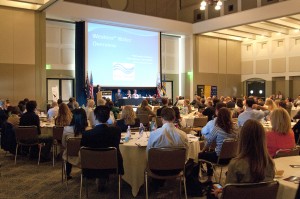In dry, sunny Los Angeles, where most of the water supply is obtained outside the region, the possibility of an extreme global water shortage hits close to home.
“Three of the last four decades have brought at least moderate if not severe drought conditions in California,” J.R. DeShazo, director of the UCLA Luskin Center for Innovation, said on Monday at a conference held in Covel Commons.”We can anticipate things to get even more challenging than they have been.”
Prompted by a shared concern over water conservation and management, experts, policy makers and dignitaries from Australia and the United States examined their respective local water issues and solutions in the context of a greater discussion about a global solution to water shortage.
Monday’s conference, “The Coming Water Crisis: Solutions and Strategies,”was co-organized by the Australian Consulate-General in Los Angeles and UCLA as part of the of the G’Day USA program, which aims to showcase various areas of industry and innovation in Australia and strengthen partnerships with the United States.

Australia and Southern California are home to comparable arid climates and have both been dealt droughts of sizable intensity in the last couple decades. In 2013, Sydney experienced the warmest year on record while the state of California had record low levels of precipitation.
Because of these pressures on the water supplies of Australia and Southern California, numerous conference speakers emphasized collaboration and shared research between the two regions’ governments as a necessary tool in tackling water issues.
“Australians have hit the mother of all multi-year droughts and learned from it, and I hope (Californians) can too,” said Felicia Marcus, chair of the California State Water Resources Control Board,who spoke as a panelist at Monday’s event. “Dealing with our current third dry year is frightening enough – a 12-year drought is unimaginable, but imagine and plan for it we must.”
A shortage of technological innovation is not the problem – rather, advances in water infrastructure or management must be implemented in specific social and cultural contexts. Improvements in technology may be hindered by an inadequately informed public and conflicting political interests, said Jeff Bleich,a former US ambassador to Australia who spoke at the conference.
“There is no lack in technology and brainpower in this room to solve the problem,” Bleich said.
Although the future water shortage has global consequences, changing people’s and governments’ understandings and attitudes about water management is essential to progress, Bleich said. Bleich’s remarks echoed similar sentiments expressed by other speakers and moderators including Beazley, and DeShazo.
For instance, two-speed flush systems for toilets, which help conserve water by using a lower flushing speed for some wastes, are standard in Australia but have not caught on with enough popularity in the United States, Bleich said. Such a move would require changing public and policymaker attitudes about water usage and persuading the public to use such inventions in their daily lives.
Panelists also said pursuing a more integrated approach – the incorporation of multiple and varied strategies – to water management is crucial to conserve water and provide long-term solutions.
“It is necessary to consider water resources in a broader system’s context through which water resources are integrated into our daily lives,” said Carol Couch,a speaker at the event and the director of Commonwealth Scientific and Industrial Research Organization’s Water for a Healthy Country National Research Flagship,a research partnership housed under Australia’s national science agency.
In November 2013, UCLA announced the project “Thriving in a Hotter Los Angeles” as part of the UCLA Grand Challenges initiative, which promised the implementation of a plan to produce water and energyself-sufficiency\in the Los Angeles region by 2050.
